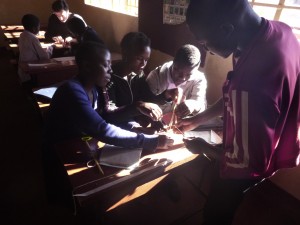Last Friday Tanya and I went on a second visit to Jacaranda School to teach an engineering workshop to Form 1 through Form 3 students. It was only two hours, but I think the students learned a lot and had a lot of fun in the process.
In the beginning of the workshop, all the students wrote down their definition of engineering/what it means to be an engineer, and then as a group we went through some of their definitions and talked about the best qualities from each one. Then, we finished off with my most basic definition of an engineer, “Engineers work on teams and use math and science to build things that help people.”
From there we talked about some of the main branches of engineering – mechanical, electrical, civil, and biomedical – and the different kinds of things specialized engineers do. I think the students were really interested to see that engineering isn’t only working on cars, and that engineers of different disciplines often work together to solve problems. After that portion, Tanya and I talked about 3 qualities that make good engineers: creativity, team work and problem solving. We did some fun group activities that tied into each of the qualities, as well, and I think the group favorite was by far the Human Knot game. In Human Knot, all the participants stand in a circle and grab two other people’s hands. (They can’t be the hands of the person right beside you, and you can’t grab both hands of a single person.) The challenge is then to “untangle the knot” that was formed without letting go of anybody’s hands.It is an exercise in team work and problem solving, to be sure, and it was great fun to watch the group dynamics evolve as the game went on and the knots became tricker.
Finally, we talked with all of the students a little bit about scoping and problem identification along with design objectives and criteria. It was a bit of a crash course into the beginning stages of the engineering design process, but important nonetheless and I think the distinction between understanding problems and coming up with solutions was an especially good lesson for them to learn.
All in all, it was a fun and informative visit. The students really seemed to enjoy learning, and I know Tanya and I had a great time teaching.
